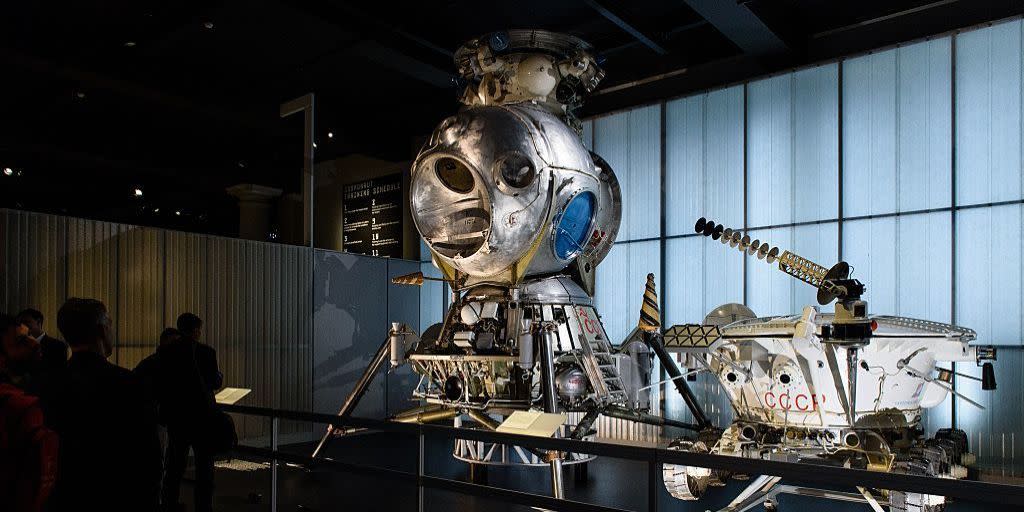Long Abandoned Soviet Tech Might Help China Land on the Moon

The Chinese space industry is buying the Soviet propulsion system designs originally intended to put humans on the Moon, well-informed sources told Popular Mechanics. As part of this new deal, a Ukrainian firm will recreate the historic engine module developed to land the first Soviet cosmonaut on the Moon ahead of the U.S.
The unique engine system designed in the former Ukrainian Soviet Socialist Republic could be crucial for accelerating China's own fledgling effort to land a man on the Moon. As the most complex and challenging part of the lunar lander design, the purchase could save Chinese engineers years of development work.
The Soviet manned lunar lander, known by its Russian abbreviation as LK for "Lunny Korabl" or Lunar Ship, was a smaller, lighter, leaner equivalent of the American "Eagle" lander, which put Neil Armstrong and Buzz Aldrin on the Moon in July 1969. America's triumphant Apollo 11 mission effectively concluded the unofficial Moon Race between the two superpowers.

By 1974, the USSR's own lunar landing effort ultimately faltered in the disastrous launches of a N1 rocket. However the Soviet LK lander, which would descend from the lunar orbit to its surface with a single cosmonaut onboard, was fully developed and ready to go.
Unlike the American lander, relying on two separate single engines for descent and takeoff, the LK used the same cluster of two engines for both the landing and the ascent. The main engine could be throttled up and down to vary its thrust as the cosmonaut maneuvered over treacherous lunar terrain. The system's main advantage over the American counterpart was its backup capability. If the main engine failed, the backup motor could always take over at any point of the flight. In contrast, on the Apollo any failure of the ascent engine meant certain death.
The development of the Soviet lunar landing propulsion system started in 1965 and the engine actually made it into space during test flights of the lunar lander prototype in Earth's orbit.
In the decades after the Space Race, the Ukrainian firm, known today as KB Yuzhnoe in the city of Dnipro, adapted the lander's unique engine for use on highly maneuverable ballistic missiles and, later, relied on the same technology to win a highly competitive contract for a small European space booster called Vega. A total of six subsequent Ukrainian engines have relied on the lunar lander technology.

Now our sources, who wished to remain anonymous, say that Chinese officials asked the Ukrainians to rebuild the very original lunar landing propulsion module using modern materials like new computer technology replacing obsolete electronics in the module's flight control system. According to the agreement, Ukrainians will transfer China the newly produced set of design documentation for the propulsion module, but the hardware itself will remain in Ukraine. In the future, Ukrainians might assist the Chinese in organizing the production of the technology in China, sources said.
Although the Chinese won't say how they plan to use the technology, sources familiar with the matter believe that China would rely on the Soviet propulsion design to build a larger lunar lander, which could carry two or even three astronauts to the Moon. Chinese could also use the system as a case study for their own lander.
Using and reverse-engineering foreign technology to get a leg up, whether exploring space or building a military, isn't a new strategy for China. During the most difficult years of the post-Soviet economic transition, Chinese experts crisscrossed Russia buying up practically any space-related technology they could find. A few years later, Chinese cosmonauts blasted into space in a Shenzhou capsule bearing striking resemblance to the Russian Soyuz spacecraft. They were even wearing spacesuits that looked like the Russian Sokol launch and entry suits.
China and the Ukraine have also collaborated before. Ukrainian propulsion specialists developed a major booster rocket engine, which today propels China's Long March rockets. KB Yuzhnoe also reportedly won numerous contracts for development or assistance with various components for rocket technology in China.
So it's very possible that one day a rocket with Soviet roots could propel Chinese astronauts to the Moon.
You Might Also Like

